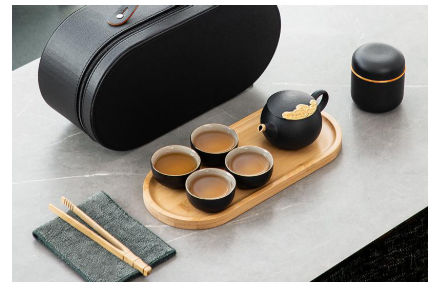How to Host a Tea Party with Your Gongfu Travel Tea Set
Introduction
Tea has long been more than just a beverage; it is a ritual, a connection to culture, and a cherished opportunity for socialization. https://www.teasetbox.com/collections/tea-sets/travel-tea-sets/ offers a range of gongfu travel tea sets that make it easier than ever to enjoy this traditional Chinese tea brewing method anywhere, whether you’re at home, in a park, or traveling abroad. The gongfu tea ceremony, a traditional Chinese method of brewing tea, elevates this experience by emphasizing skill, precision, and appreciation for the intricacies of the tea leaves.
With the advent of the gongfu travel tea set, the beauty of this ritual can now be enjoyed anywhere—whether you are in the comfort of your home, at a park, or on a journey abroad. These compact sets are designed with portability in mind, allowing tea enthusiasts to engage in the artistry of tea brewing while maintaining the essence of the gongfu tradition.
In this guide, we will explore how to host a memorable tea party using a gongfu travel tea set. From selecting the perfect teas to preparing the setup and enhancing the overall experience for your guests, we will equip you with everything you need to embrace the art of tea. So, let’s delve into the ritualistic world of tea, unpacking the tools and techniques that transform a simple gathering into an elegant and meaningful tea affair.
Understanding Gongfu Tea Ceremonies
The gongfu tea ceremony, rooted in Chinese culture, is a sophisticated and intimate way to brew and enjoy tea. The term “gongfu,” which translates to “skill” or “effort,” highlights the craftsmanship involved in this artful brewing technique. Unlike more casual tea-making methods, gongfu emphasizes precision, patience, and a deep appreciation for the flavor and aroma of different tea types.
The Essence of Gongfu Tea
At the core of the gongfu tea ceremony is the idea of bringing together the best qualities of tea leaves, water, and brewing techniques. The primary focus lies in utilizing high-quality loose-leaf tea, which is often appreciated for its richer flavors compared to tea bags. While many types of tea can be used in a gongfu ceremony—including oolong, green, black, and pu-erh—oolong tea is perhaps the most traditional.
Gongfu tea preparation involves several steps:
- Preparation of Tools: A gongfu tea set consists of a small teapot or a gaiwan (a lidded bowl), several small teacups, a serving pitcher, a tea tray, and a kettle. Each element is selected for both functionality and aesthetics, promoting an immersive experience.
- Tea Selection: Choosing the right tea can dramatically affect the ceremony. Different teas require different brewing times and water temperatures, leading to unique flavor profiles.
- Brewing Techniques: The gongfu method typically involves multiple short steeps, allowing guests to experience the intricate flavors of the tea as it evolves over time. This process invites atmosphere and attention, allowing the host to control the brewing duration, water temperature, and the quantity of leaves used.
Cultural Significance
Beyond its practical aspects, the gongfu tea ceremony is steeped in cultural meaning. It represents hospitality, respect, and connection among participants. Traditionally, it is a way to honor guests, allowing them to savor not just the tea but the time spent together. The gentle pouring of tea, the sharing of warm waters, and the intentional pauses create a tranquil setting that encourages conversation and reflection.
Elevating the Experience
Engaging in a gongfu tea ceremony can serve as an enriching escape from the fast pace of modern life. It invites practitioners and guests to slow down and focus on the present moment, cultivating mindfulness and appreciation for the simple pleasures. Moreover, it serves as a beautiful backdrop for storytelling, offering opportunities to share the history and origin of the teas being enjoyed.

Choosing the Perfect Tea for Your Party
Selecting the right tea is a vital component of hosting a memorable gongfu tea party. The type of tea you choose not only sets the tone for the gathering but also influences the overall experience for your guests. Below are some key considerations and suggestions to help you choose the perfect tea for your occasion.
1. Type of Tea
The world of tea is rich and diverse, with various types—each possessing unique flavors and characteristics. When hosting a gongfu tea party, consider the following popular options:
- Oolong Tea: Known for its complexity, oolong offers a range of flavors from floral to roasted. Popular varieties like Tie Guan Yin (Iron Goddess of Mercy) or Da Hong Pao (Big Red Robe) can captivate your guests’ taste buds and provide a delightful experience with multiple infusions.
- Green Tea: For a fresh and invigorating option, opt for high-quality green teas like Longjing (Dragon Well) or Gyokuro. The light and refreshing profile of green tea can complement warmer weather, making it a great choice for outdoor gatherings.
- Pu-erh Tea: Rich and earthy, pu-erh tea can be an exciting addition to your menu. Often enjoyed in its compressed form, it offers a unique sensory journey, especially when compared to other types.
- White Tea: If you’re looking for something delicate, consider white tea varieties like Silver Needle or White Peony. Their subtle flavors and elegant profiles can create a serene atmosphere ideal for intimate gatherings.
2. Season and Occasion
Aligning your tea selection with the season or occasion can enhance the overall experience.
- Spring and Summer: Lighter teas such as green or white varieties are refreshing and uplifting during warmer months. Consider serving chilled tea or tea-infused cocktails to keep your guests cool.
- Fall and Winter: Hearty and robust teas, including aged pu-erh or darker oolong teas, are perfect for cooler seasons. The warmth and richness can create a cozy ambiance, ideal for bonding and conversation.
3. Guest Preferences
Understanding the preferences of your guests can also significantly impact your tea selection. Before your party, poll your guests on their preferred types of tea or flavors. This thoughtfulness can make your event feel personalized and inclusive, making everyone feel welcome.
4. Multiple Options for Variety
Incorporating a selection of teas can cater to diverse palates and encourage exploration. Consider offering:
- A flight of teas: Present a curated selection that ranges from lighter to heavier blends, encouraging guests to taste and compare their favorite flavors.
- Flavored or Herbal Teas: Integrate herbal teas or flavored blends as alternatives for those who may not enjoy traditional teas. This ensures there’s something for everyone and reflects your thoughtfulness as a host.
5. Quality over Quantity
Lastly, prioritize quality over the number of options available. Good quality tea enhances the gongfu brewing method, allowing the flavors to unfold beautifully in each steep. Investing in high-grade loose-leaf teas will elevate the traditional tea ceremony, providing a more enriching experience for your guests.

Setting the Scene for Your Tea Party
Creating the right ambiance for your gongfu tea party is just as important as the tea selection. The atmosphere enhances the experience, transforming the gathering into a memorable occasion. Here are some essential elements to consider when setting the scene for your tea party:
1. Choose the Right Location
Selecting the perfect location is pivotal for your tea gathering. Opt for a quiet and comfortable space—whether it’s an inviting corner of your home, a serene garden, or a cozy outdoor patio. Ensure the area is free from distractions, allowing guests to engage in meaningful conversations while enjoying their tea. If you’re hosting indoors, consider the time of day. Natural light adds warmth and a welcoming feel, while evening gatherings can be illuminated with soft lighting or candles to create a more intimate atmosphere.
2. Decorate with Purpose
Your decor should reflect the tranquility and elegance of the gongfu tea ceremony. Simple and minimalist designs work best, as they draw attention to the tea itself. Incorporate natural elements like fresh flowers, bamboo, or stones, which resonate with the philosophy of simplicity and harmony in tea culture. Use elegant tableware that complements your travel tea set—think earthy tones or delicate ceramics. A well-set table elevates the dining experience and contributes to the overall aesthetic.
3. Arrange Your Tea Set
Arrange your gongfu tea set in an accessible yet visually appealing manner. Position the teapot, gaiwan, or tea cups in a way that invites guests to participate in the tea-making process. Ensure that your travel set is clean and that all necessary utensils—such as a tea strainer, tea scoop, and kettle—are conveniently placed. If possible, create a designated area for serving the tea, allowing guests to gather closely and interact while brewing.
4. Create a Relaxing Soundscape
Sound can significantly influence the mood of your gathering. Consider playing soft, calming music or nature sounds in the background to enhance the tranquility of the scene. Instrumental music, such as traditional Chinese guzheng or bamboo flute melodies, can complement the essence of a gongfu tea ceremony, providing a serene backdrop without being overwhelmingly distracting.
5. Set the Temperature and Aroma
Make sure the temperature is comfortable for your guests. If you’re outdoors, provide blankets or set up a shaded area if it’s sunny. Indoors, ensure good ventilation and consider using an essential oil diffuser with calming scents like jasmine or chamomile that align with the tea. Aromas play an essential role in relaxation and can enhance the sensory experience of tasting teas.
6. Encourage Conversation and Engagement
Lastly, foster an environment conducive to conversation and connection. Consider introducing each tea you serve with a brief story or anecdote about its origin or brewing method. This turns the tea party into an engaging experience, encouraging guests to share their thoughts and preferences. Guided discussions can help create an enjoyable atmosphere, allowing everyone to participate and bond over the shared appreciation of tea.
Preparing Your Gongfu Travel Tea Set
Hosting an enjoyable tea party requires careful preparation of your gongfu travel tea set. The beauty of this portable collection lies not only in its compact design but also in the intricate brewing process it offers. Here is a comprehensive guide to ensure you are fully prepared to impress your guests with a delightful tea experience.
1. Gather Essential Components
Before you head out for your tea party, ensure that you have all the essential components of your gongfu travel tea set. This typically includes:
- Tea Pot: Ideally a small, ornate teapot made of clay or porcelain designed for the gongfu style.
- Tea Cups: Small, handle-less cups that allow for a more intimate tasting experience.
- Tea Strainer: A fine mesh strainer to catch tea leaves when pouring.
- Tea Scoop: Used to measure the right amount of tea leaves for brewing.
- Kettle or Thermos: To hold your hot water, preferably one that can maintain temperature for optimal brewing.
- Tea Tray: A small tray to catch any drips and provide a neat serving area.
2. Choose Teas Wisely
The selection of tea plays a crucial role in your gathering. Opt for a variety of high-quality loose leaf teas that will cater to different preferences. Popular choices for gongfu brewing include:
- Oolong Tea: Known for its complexity and variety of flavors.
- Pu-erh Tea: Offers rich earthy notes and is great for experienced tea drinkers.
- White Tea: Delicate and refreshing, ideal for a lighter palate.
- Green Tea: Fresh and grassy, appreciated by those who prefer a more invigorating brew.
Consider including a few unique blends to surprise your guests and spark interesting conversations about their flavor profiles.
3. Pre-Boil Water and Temperature Control
Water temperature is crucial in gongfu tea brewing, as different teas require different temperatures to release their unique flavors. For instance:
- Oolong tea often brews best at around 190-200°F (88-93°C).
- Green tea typically requires cooler water, around 160-180°F (70-80°C).
- Pu-erh can be brewed with boiling water, approximately 212°F (100°C).
Pre-boil your water and allow it to cool to the desired temperature for each type of tea, or, if using a thermos, keep your water hot but not boiling.
4. Prepare Your Brewing Space
Once you arrive at your tea party location, take a moment to arrange your brewing space. Lay out your tea tray, ensuring it’s clean and dry. Set up your tea pot and cups in an aesthetically pleasing manner. Arrange the loose leaf teas in small containers labeled with their names and steeping instructions so that guests can see the variety available.
5. Mindfulness in Brewing
Gongfu tea ceremonies emphasize mindfulness and appreciation. As you prepare for brewing, encourage a peaceful atmosphere by engaging your guests in the process. Invite them to observe each step: the aroma of the dry leaves, the pouring of hot water, and the art of steeping. This not only enhances their appreciation of tea but also enriches their overall experience, transforming the tea party into a cherished memory.
6. Opt for Cleanliness and Hygiene
A clean and hygienic tea set enhances the quality of your tea experience. Rinse your tea pot and cups with hot water before serving to warm them up and cleanse any residual scent or taste from prior use. It’s also considerate to have a small towel or cloth nearby for any spills or drips, keeping your space tidy as you brew.
Inviting Guests and Creating an Itinerary
Once you’ve chosen the perfect setting for your gongfu tea party, it’s time to focus on inviting friends or family and crafting an itinerary that enhances the overall experience. The right mix of guests and a well-structured agenda can turn a simple gathering into a delightful celebration of tea culture.
1. Selecting Your Guests
When choosing your guests, consider those who share an interest in tea or have a curiosity about exploring new cultures. A diverse group can foster enlightening discussions about tea varieties, brewing methods, and personal preferences. Think about inviting:
- Tea enthusiasts who can appreciate the nuances of flavor.
- Friends who are looking for a relaxing experience or social outing.
- Family members who may not yet know about the joy of gongfu tea ceremonies but would appreciate a unique experience.
Reach out to your potential guests with a personal touch, either through elegant invitations or informal messages emphasizing the theme of the gathering. Highlight the experience they’ll gain, such as learning brewing techniques and tasting exquisite teas.
2. Setting an Itinerary
Creating a structured yet flexible itinerary can help ensure that your tea party flows smoothly while allowing room for spontaneous enjoyment. Here’s a suggested framework:
- Welcome and Introduction (15 minutes): Greet your guests warmly and introduce them to the concept of gongfu tea. Share a brief history or stories about different teas you’ll be serving.
- Brewing Demonstration (20 minutes): Begin with a live demonstration of brewing techniques. Explain the significance of different steps such as rinsing the leaves, timing for steeping, and the importance of water temperature.
- Tea Tasting (30 minutes): Serve a selection of teas, allowing guests to taste each one while discussing its characteristics. Encourage them to share their thoughts and preferences, fostering an interactive atmosphere.
- Mindfulness Moment (10 minutes): Set aside time for a brief mindfulness exercise where guests can appreciate the tastes, aromas, and sensations of each tea. This moment can deepen their connection to the experience.
- Casual Conversation and Reflection (30 minutes): Allow guests to sip tea at their leisure while engaging in conversation about their experiences, challenges, and delights in tea drinking.
- Conclusion and Farewell (15 minutes): End on a gracious note by thanking your guests for attending. Consider offering them a small favor, like a sample of one of the teas, to take home and remember the event.
3. Flexibility is Key
While having a structured itinerary is beneficial, remain open to altering the agenda based on your guests’ energy and engagement levels. Encourage them to ask questions and explore the tea culture passionately and thoroughly. Adapt the pace to ensure everyone is enjoying themselves, making it a memorable celebration for all.
Conducting the Tea Ceremony
Hosting a gongfu tea ceremony is not just about serving tea; it is an immersive experience that involves attention to detail, mindfulness, and respect for the tea and the guests alike. Below are steps and considerations to ensure your tea ceremony flows smoothly and becomes a memorable occasion for everyone involved.
1. Setting the Scene
Before your guests arrive, create an inviting atmosphere. Choose a serene location with minimal distractions, and set up a beautifully arranged tea table. Use a clean cloth or mat to enhance the aesthetic, and lay out your gongfu tea set, which typically includes a teapot, tea cups, a tea tray, and a pitcher for serving. Incorporate elements of nature—such as a small flower arrangement or a few stones—to further complement the tranquility of the space.
2. Preparing the Tea
Select high-quality loose-leaf teas suitable for a gongfu ceremony. Popular choices include Oolong, Pu-erh, and various green teas, each offering a unique flavor profile. Prior to the ceremony, rinse the teapot and cups with hot water to warm them up and remove any residue, thus ensuring the purity of the tea’s flavor. It’s also common to perform a ritualistic rinse of the tea leaves themselves—this helps to awaken the leaves and washes away any dust from processing.
3. The Brewing Process
As you begin brewing, engage your guests with a detailed explanation of the gongfu method. Here’s a basic outline:
- Measure the Leaves: Use a scale or a spoon to precisely measure the amount of tea leaves required. Typically, the ratio is about 1-2 grams of leaves per ounce of water. Share the significance of this measurement with your guests and allow them to appreciate the delicate balance involved in tea preparation.
- Water Temperature and Timing: Discuss the ideal water temperatures for each type of tea, which can range from 160°F for green teas to 212°F for robust black teas. Timing is crucial; highlight how different steeping times extract different flavor complexities. For example, short steeping times (10-30 seconds) reveal softer notes, while longer times can enhance bolder flavors.
- Pouring Techniques: Demonstrate the art of pouring—it’s not just about filling cups but rather appreciating aesthetics. Use a graceful motion to pour tea into each cup while explaining the significance of this step, emphasizing the harmony and respect for the tea and each guest.
4. Engaging Your Guests
As the tea brews, invite your guests to participate. Encourage them to observe the color, sniff the aroma, and savor the taste. This sensory experience deepens their connection to the tea and the tradition. Allow everyone to sample the tea, discussing the flavors and aromas and inviting guests to reflect on their personal experiences with tea.
5. The Ritual of Sharing
In the spirit of gongfu tea culture, sharing is essential. After brewing, serve the tea from a common pitcher into individual cups, ensuring that all guests receive equal amounts of the brew. This act fosters a sense of community and sharing. You can also share a brief story or anecdote about the tea being served, enhancing the experience with cultural richness.
6. Concluding the Ceremony
As the ceremony draws to a close, encourage your guests to express their thoughts about the teas tasted. Engage in a thoughtful discussion about the finer nuances of each blend encountered during the ceremony. Acknowledge the common ground shared through this experience and encourage guests to take the lessons and memories formed with them.
Conducting a gongfu tea ceremony is about creating a sacred space to appreciate not only the tea itself but the connections formed between those gathered. With careful preparation and a mindful approach, your tea ceremony can become a cherished memory for everyone involved—an exquisite blend of flavors, insights, and shared enjoyment.
Pairing Snacks and Light Bites with Tea
The experience of a gongfu tea ceremony is heightened not only by the tea itself but also by the delightful snacks and light bites that accompany it. Selecting the right food can enhance the flavors of your tea, create harmony in the tasting experience, and provide nourishment for your guests. Below are some thoughtful pairings that complement various types of tea, ensuring a well-rounded and enjoyable tea party.
1. Understanding Flavor Profiles
Before choosing snacks, it’s important to understand the flavor profiles of the teas you’ll be serving. Different teas possess distinct characteristics influenced by their processing methods, origin, and the specific leaves used. Here’s a simple guide to help you make informed pairings:
- Green Teas: Often fresh and grassy, green teas such as Dragon Well or Sencha pair beautifully with light, crisp snacks. Consider serving rice crackers, edamame, or cucumber sandwiches. These foods enhance the tea’s refreshing qualities without overpowering them.
- Oolong Teas: With a complexity that combines floral and fruity notes, oolong teas like Tie Guan Yin or Da Hong Pao shine alongside slightly savory and creamy bites. Try pairing with cheese platter, roasted nuts, or vegetable dumplings. The creaminess of cheese, for example, complements the smooth texture of oolong.
- Black Teas: Bold and robust, black teas such as Assam or Earl Grey pair well with richer snacks. Consider offering dark chocolate, scones with clotted cream, or spiced cookies. The sweetness and spice of these snacks balance the strong flavors of black teas beautifully.
- Pu-erh Teas: Earthy and robust, pu-erh works well with hearty snacks. Think of pairing it with charcuterie, smoked meats, or even grilled vegetables. The savory elements accentuate the depth of pu-erh, creating a richly satisfying experience.
2. Sweet vs. Savory
When considering snacks for your tea party, it’s essential to balance sweet and savory options. This combination can elevate the tasting experience. Sweet snacks like madeleines, fruit tarts, or honey-dipped pastries can provide a delightful contrast to the sometimes astringent nature of certain teas. On the other hand, savory treats can ground the palate, ensuring that guests don’t feel overwhelmed by sweetness.
3. Mindful Presentation
The presentation of snacks is an extension of the gongfu tea ethos—careful and graceful. Serve snacks on attractive platters or tiered stands, highlighting their colors and textures. Consider using small, elegant plates or bamboo platters that evoke a natural aesthetic consistent with tea culture. This attention to detail not only pleases the eye but enhances the overall experience of the ceremony.
4. Dietary Considerations
Lastly, keep your guests’ dietary preferences and restrictions in mind. Offering a variety of options—vegan, gluten-free, or nut-free—ensures that everyone can partake in the joys of your tea party. Labeling snacks can also be helpful, allowing guests to choose safely.
5. Toasting with Tea
As you pair your snacks with tea, don’t forget to engage in moments of toasting or sharing the stories behind the snacks. This mingling of flavors and shared experiences can make your tea gathering even more memorable.
Capturing Memories of Your Tea Party
Hosting a tea party with your best gongfu travel tea set is not just about savoring delicious brews and snacks; it’s also a wonderful opportunity to create lasting memories with loved ones. Here are several creative ways to capture the essence of your tea gathering, ensuring that the special moments you share linger long after the last cup has been poured.
1. Photography Corner
Set up a dedicated space for photographs. Create a visually appealing backdrop using a beautiful tablecloth, fresh flowers, or even a traditional Chinese painting. Encourage guests to take pictures with the gongfu tea set, showcasing the elegance of the ceremony. You might also consider having props that reflect the theme of your gathering, such as decorative tea cups or charming tea-themed quotes. A group photo can serve as a great reminder of the joyous occasion.
2. Themed Guest Book
Create a guest book infused with the spirit of your tea party. Instead of a traditional book, consider a beautiful tea-themed notepad where guests can write their thoughts about the experience, their favorite tea, or even memorable quotes shared during the gathering. This unique keepsake can be revisited in the future, sparking fond memories of your tea parties and enhancing the personal connection between you and your guests.
3. Scented Souvenirs
Send your guests home with a small token of appreciation that encapsulates the flavors and aromas of the day. Consider sachets filled with tea blends or loose leaf tea that were featured during your party. Creating personalized labels or tags with the date and a brief description of the tea will add a memorable touch. This gift not only reminds them of the experience but also encourages them to recreate a similar gathering, fostering a community of tea enthusiasts.
4. Reflective Notes
Encourage guests to share their favorite moments or thoughts on the experience. Set out slips of paper where they can jot down a quick note during the tea session. Collect these notes and compile them in a decorative jar or envelopes that can be revisited in the future. This practice creates a sense of anticipation for future gatherings, as everyone can look back on shared sentiments and reminisce about the delightful conversations enjoyed during the event.
5. Social Media Sharing
In this digital age, social media provides an excellent platform for sharing your tea party experiences. Designate a unique hashtag for your gathering, and encourage guests to post their favorite moments on social media. This will not only document the event but also allow friends who couldn’t attend to be part of the experience remotely. Remember to respect the privacy of your guests; make sure they’re comfortable with sharing photos before posting online.
Conclusion
As you wrap up your delightful gathering, it’s essential to leave your guests with lasting impressions of both the tea and the unique experience you’ve shared. A gongfu tea party is about more than just tasting exquisite teas; it’s about creating connections, stimulating conversations, and fostering a deeper appreciation for this ancient tradition.
Encourage your guests to reflect on what they learned during the event, whether it’s a new brewing technique, a newfound favorite tea, or simply the joy of sharing the moment with friends and family. Providing each guest with a small token, such as a sample of one of the teas served or a beautifully crafted tea accessory, can serve as a lovely reminder of the experience.
Additionally, consider gathering feedback from your guests about their favorite moments, teas, or anything they might like to explore further. This insight not only enriches your future gatherings but also creates a sense of community among tea enthusiasts.
Lastly, don’t forget to express your gratitude to your guests for attending. A heartfelt thank-you note or a follow-up message can go a long way in nurturing your relationship with them and inviting them back for future tea parties. As the leaves steep, so, too, do friendships deepen—nurtured one cup at a time. Your gongfu travel tea set has not only facilitated a delicious experience but has also become a vessel for shared stories and cherished memories, ensuring that each sip is savored long after the last drop is gone.










